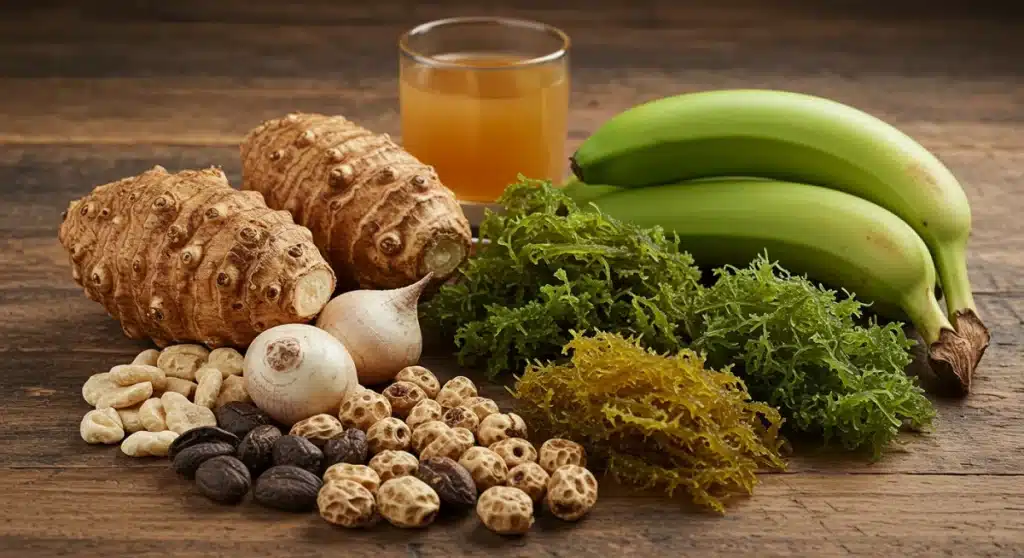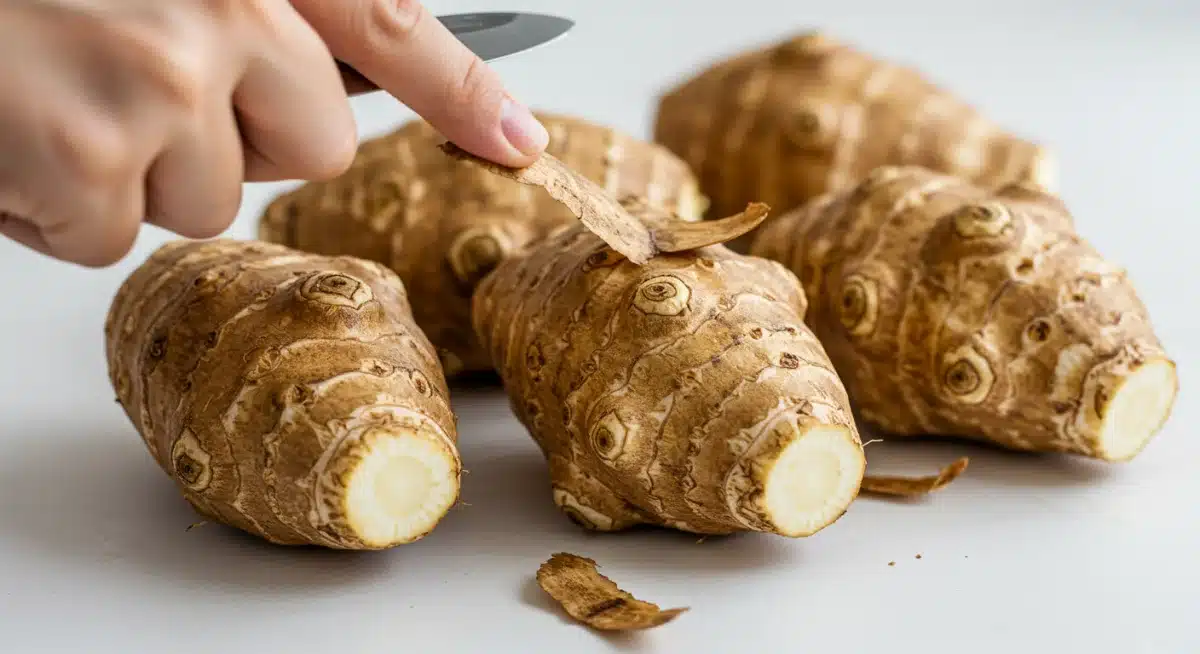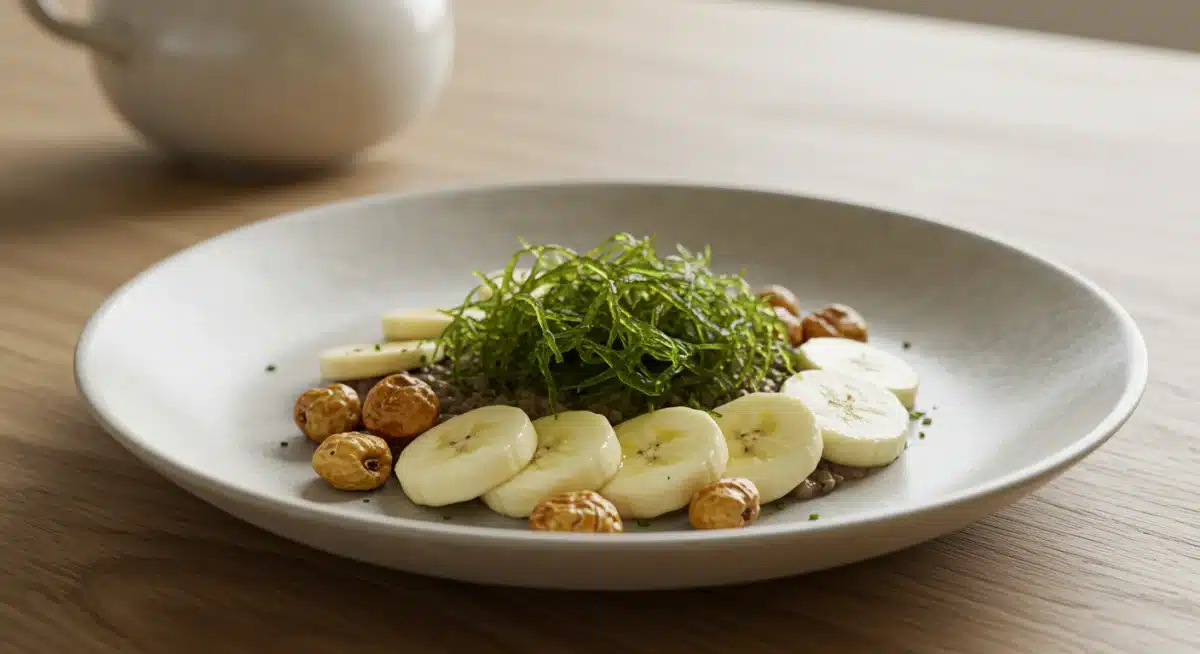Unlock 7 Lesser-Known Superfoods for Optimal Gut Health in 2025

Optimizing gut health is crucial for overall well-being, and this guide introduces seven lesser-known superfoods offering unique benefits for a balanced and thriving microbiome in 2025.
As we step into 2025, the conversation around health and wellness continues to evolve, placing a significant emphasis on the intricate ecosystem within our digestive tract. Understanding how to nurture this vital system is key to unlocking holistic well-being. This guide aims to introduce you to an exclusive list of gut health superfoods that are poised to make a significant impact in the coming year, moving beyond the usual suspects to offer fresh, potent options for your microbiome.
The Evolving Landscape of Gut Health Nutrition
The science of gut health is rapidly advancing, revealing increasingly complex connections between our digestive system and nearly every other aspect of our health, from mood and immunity to metabolism and chronic disease prevention. What we consume directly influences the diversity and balance of our gut microbiome, a community of trillions of microorganisms that play a pivotal role in these bodily functions. For years, probiotics and fermented foods have dominated the discussion, and rightly so, but 2025 brings a deeper dive into lesser-known, yet incredibly potent, nutritional powerhouses.
This evolving understanding necessitates a shift in our approach to diet, encouraging us to explore ingredients that offer unique benefits beyond general nutrition. The focus is now on targeted support for specific microbial populations and the production of beneficial compounds. This section will lay the groundwork for why these emerging superfoods are becoming indispensable in the pursuit of optimal gut health.
Beyond Traditional Probiotics: Prebiotic Powerhouses
While probiotics introduce beneficial bacteria to the gut, prebiotics act as food for these good microbes, encouraging their growth and activity. Many of the superfoods we’ll explore are rich in diverse types of prebiotics, offering a broader spectrum of support than commonly found in everyday diets.
- Targeted Microbial Support: Specific fibers and compounds in these superfoods feed particular strains of beneficial bacteria.
- Enhanced Butyrate Production: Many promote the production of short-chain fatty acids like butyrate, crucial for gut barrier integrity and anti-inflammatory responses.
- Improved Nutrient Absorption: A healthy microbiome can also enhance the absorption of vitamins and minerals from your food.
The journey towards a healthier gut is not merely about adding good bacteria, but about creating an environment where they can thrive and perform their myriad functions effectively. This holistic view is what underpins the selection of the superfoods discussed in this guide, emphasizing their role in fostering a resilient and diverse gut ecosystem.
In essence, the future of gut health nutrition in 2025 is about intelligent choices – selecting foods that provide foundational support and specialized benefits for our internal microbial gardens. Moving forward, understanding these nuanced contributions will empower individuals to make more informed dietary decisions, moving beyond generic advice to truly personalized and effective strategies for digestive wellness.
Sunchokes (Jerusalem Artichokes): The Prebiotic Powerhouse
Often overlooked in mainstream diets, sunchokes, also known as Jerusalem artichokes, are emerging as a leading contender in the realm of gut health superfoods for 2025. Despite their name, they are not related to artichokes and are actually a species of sunflower. Their knobby appearance belies their incredible nutritional value, particularly their high concentration of inulin, a powerful prebiotic fiber that stands out for its profound impact on the gut microbiome.
Inulin is a type of fructan that resists digestion in the upper gastrointestinal tract, traveling intact to the large intestine where it becomes a primary food source for beneficial gut bacteria, especially Bifidobacteria and Lactobacilli. This selective feeding promotes the growth of these health-promoting microbes, leading to a cascade of positive effects on digestive health and beyond.

Maximizing Sunchoke Benefits
Integrating sunchokes into your diet can be surprisingly versatile. They can be eaten raw, thinly sliced in salads for a crisp, slightly sweet and nutty flavor, or cooked. Roasting, steaming, or boiling them can soften their texture and bring out their subtle sweetness. However, it’s worth noting that cooking can slightly reduce their inulin content, so a mix of raw and cooked consumption is ideal for maximizing benefits.
- Raw in Salads: Thinly slice for a crunchy texture and maximum prebiotic content.
- Roasted or Steamed: A delicious side dish, offering a potato-like consistency with a unique flavor.
- Pureed into Soups: Adds creaminess and a nutritional boost without dairy.
While incredibly beneficial, introducing sunchokes rapidly or in large quantities can sometimes lead to digestive discomfort due to their high inulin content. It’s advisable to start with small portions and gradually increase intake, allowing your gut microbiome time to adjust to this potent prebiotic source. This gradual approach ensures you reap the benefits without unnecessary side effects.
The unique composition of sunchokes makes them an excellent addition for anyone looking to seriously boost their gut health in 2025. Their ability to selectively nourish beneficial bacteria and contribute to a more diverse microbiome positions them as a true superfood, offering a natural and effective way to enhance digestive wellness and overall vitality.
Tiger Nuts: The Resistant Starch Revelation
Despite their name, tiger nuts are not actually nuts but small, tuberous root vegetables native to the Mediterranean and North Africa. They are gaining significant traction in 2025 as a gut health superfood, primarily due to their exceptionally high content of resistant starch. This unique type of starch resists digestion in the small intestine, passing through to the large intestine where it ferments and acts as a potent prebiotic, feeding beneficial gut bacteria.
The resistant starch in tiger nuts contributes significantly to the production of short-chain fatty acids (SCFAs), particularly butyrate, which is crucial for maintaining the integrity of the gut lining and reducing inflammation. A healthy gut lining acts as a barrier, preventing harmful substances from entering the bloodstream, a concept increasingly recognized as vital for overall health and disease prevention.
Incorporating Tiger Nuts into Your Diet
Tiger nuts offer a sweet, nutty flavor and a chewy texture, making them a versatile ingredient. They can be enjoyed raw as a snack, added to trail mixes, or ground into flour for gluten-free baking. Tiger nut milk, a dairy-free alternative, is also a popular way to consume them and can be used in smoothies or cereals, providing a creamy texture and a dose of prebiotics.
- Snack on Raw Tiger Nuts: A convenient and satisfying way to boost fiber intake.
- Tiger Nut Flour: Excellent for gluten-free baking, adding a unique flavor and nutritional profile.
- Tiger Nut Milk: A delicious plant-based milk alternative for drinks and recipes.
Beyond resistant starch, tiger nuts are also rich in other beneficial nutrients, including fiber, iron, potassium, and vitamins C and E. This comprehensive nutritional profile further enhances their status as a superfood, offering benefits that extend beyond gut health to overall vitality and well-being. Their natural sweetness means they can also help curb sugar cravings, contributing to a healthier diet overall.
The revelation of tiger nuts as a significant source of resistant starch makes them an invaluable addition for those aiming to optimize their gut microbiome in 2025. Their dual role as a delicious snack and a powerful prebiotic makes them an easy and enjoyable way to support digestive health and foster a thriving internal ecosystem.
Green Bananas: Unripe Goodness for Your Gut
While ripe bananas are a popular and convenient fruit, it’s their unripe, green counterparts that are garnering significant attention as a top gut health superfood for 2025. The key difference lies in their starch content. As bananas ripen, their resistant starch converts into simple sugars. Green bananas, however, retain high levels of resistant starch, making them an exceptional prebiotic source for the gut microbiome.
This resistant starch acts similarly to that found in tiger nuts, bypassing digestion in the small intestine and fermenting in the large intestine. This fermentation process produces short-chain fatty acids, vital for nourishing gut cells, maintaining gut barrier integrity, and exerting anti-inflammatory effects throughout the body. The consistent supply of these SCFAs is crucial for a robust and healthy digestive system.
Best Ways to Consume Green Bananas
Eating green bananas raw might not be appealing due to their firm texture and slightly bitter taste. However, there are numerous delicious ways to incorporate them into your diet to reap their gut-boosting benefits. Cooking them can soften their texture while retaining their resistant starch, especially if not overcooked.
- Boiled or Steamed: Can be used as a starchy side dish, similar to potatoes.
- Green Banana Flour: A versatile gluten-free flour for baking, smoothies, and thickening sauces.
- Smoothies: Blending raw green bananas with other ingredients can mask their tartness.
The versatility of green bananas, particularly in flour form, makes them an accessible ingredient for a wide range of culinary applications. From baking breads and muffins to thickening soups and stews, green banana flour allows for the easy integration of resistant starch into everyday meals without significantly altering flavor profiles. This makes it an ideal choice for sustained gut health support.
Embracing green bananas as a regular part of your diet in 2025 offers a simple yet powerful strategy for enhancing gut health. Their high resistant starch content provides essential fuel for beneficial gut bacteria, contributing to a diverse and resilient microbiome, which is foundational for overall health and vitality.
Jicama: The Crunchy Prebiotic Root
Jicama, a crisp, sweet, and starchy root vegetable native to Mexico, is gaining recognition as a valuable gut health superfood for 2025. Its unassuming appearance belies its rich nutritional profile, particularly its high content of inulin-type fructans and other dietary fibers. These compounds are powerful prebiotics, selectively feeding beneficial bacteria in the gut and promoting a healthy microbial balance.
Beyond its prebiotic benefits, jicama is also an excellent source of vitamin C, an important antioxidant that supports immune function, and various minerals. Its high water content and fiber contribute to feelings of fullness, aiding in weight management, and promoting regular bowel movements, essential for a well-functioning digestive system.
Enjoying Jicama for Gut Health
Jicama’s mild, slightly sweet flavor and crunchy texture make it incredibly versatile and enjoyable to eat raw. It can be peeled and sliced into sticks for a refreshing snack, added to salads for extra crunch, or incorporated into slaws. Its ability to absorb flavors also makes it a great addition to stir-fries, though it’s best added towards the end of cooking to maintain its crispness.
- Raw Snack Sticks: A healthy, hydrating, and fiber-rich alternative to chips.
- Salad and Slaw Ingredient: Adds a unique texture and subtly sweet flavor.
- Lightly Cooked in Stir-fries: Provides crunch and nutrients without heavy cooking.
The ease of preparation and pleasant taste of jicama make it an accessible superfood for daily consumption. Unlike some other high-fiber foods, jicama is generally well-tolerated, making it an excellent choice for individuals looking to gently increase their prebiotic intake without significant digestive upset. Its hydrating properties further contribute to digestive comfort and overall gut function.
As we look to enhance our gut health in 2025, jicama stands out as a delicious and effective option. Its blend of prebiotic fibers, vitamins, and minerals makes it a comprehensive choice for supporting a thriving gut microbiome, contributing to both digestive wellness and broader health benefits.
Sea Moss: The Mineral-Rich Gut Healer
Sea moss, a type of red algae, is rapidly ascending in popularity as a potent gut health superfood for 2025, championed for its impressive mineral content and unique prebiotic properties. Harvested from the ocean, this marine vegetable is a powerhouse of essential nutrients, boasting 92 of the 102 minerals our bodies need, including iodine, potassium, calcium, and magnesium. These minerals are crucial for countless bodily functions, including optimal digestive processes.
What truly sets sea moss apart for gut health is its mucilaginous texture, which forms a gel-like substance when rehydrated. This gel coats the digestive tract, soothing irritated mucous membranes and acting as a demulcent. Furthermore, the complex carbohydrates in sea moss, particularly carrageenans, function as prebiotics, nourishing beneficial gut bacteria and supporting a balanced microbiome. This dual action makes it a unique and effective gut healer.

Utilizing Sea Moss for Wellness
Sea moss is most commonly consumed in gel form, which can be easily made at home by soaking and blending the dried algae. This gel can then be added to smoothies, teas, soups, or even used as a thickening agent in recipes. Its mild taste means it can be incorporated into a variety of dishes without overpowering other flavors, making it a versatile addition to any diet.
- Smoothie Booster: A spoonful of sea moss gel enriches smoothies with minerals and prebiotics.
- Thickener for Soups and Sauces: Provides a natural, nutrient-dense thickening alternative.
- Wellness Shots: Combine with lemon, ginger, and honey for an invigorating health tonic.
Beyond its internal benefits, sea moss is also gaining traction for topical applications, particularly in skincare, due to its hydrating and mineralizing properties. However, for gut health, consistent internal consumption is key. It’s important to source high-quality, wildcrafted sea moss to ensure maximum purity and nutrient density, avoiding products that may contain fillers or contaminants.
The comprehensive nutritional profile and unique gut-healing properties of sea moss position it as an indispensable superfood for those committed to optimizing their digestive health in 2025. Its ability to soothe, nourish, and rebalance the gut makes it a powerful ally in the pursuit of a vibrant and resilient microbiome.
Sorghum: The Ancient Grain with Modern Gut Benefits
Sorghum, an ancient grain that has been a dietary staple in various cultures for centuries, is experiencing a resurgence in 2025 as a significant gut health superfood. Naturally gluten-free, sorghum is rich in dietary fiber, particularly resistant starch, and a diverse array of phenolic compounds, including powerful antioxidants. These components work synergistically to promote a healthy gut microbiome and overall digestive wellness.
The resistant starch in sorghum, like that found in green bananas and tiger nuts, acts as a prebiotic, fermenting in the large intestine to produce beneficial short-chain fatty acids. These SCFAs not only nourish gut cells but also contribute to a balanced pH, inhibiting the growth of pathogenic bacteria and supporting the proliferation of beneficial ones. Furthermore, sorghum’s polyphenols may also influence microbial composition and activity positively.
Cooking with Sorghum for Optimal Gut Health
Sorghum is incredibly versatile and can be used in various forms, including whole grain, flour, and syrup. Whole grain sorghum can be cooked and used as a side dish, added to salads, or incorporated into stews, offering a chewy texture and mild, slightly nutty flavor. Sorghum flour is an excellent gluten-free alternative for baking, providing structure and nutritional benefits to breads, muffins, and pancakes.
- Whole Grain Sorghum: A healthy substitute for rice or quinoa in meals.
- Sorghum Flour: Ideal for gluten-free baking, improving texture and nutrient content.
- Popped Sorghum: A light, airy snack similar to popcorn, but smaller and more nutrient-dense.
The robust nutritional profile of sorghum, combined with its accessibility and versatility, makes it an excellent choice for anyone looking to diversify their diet and enhance their gut health. Its high fiber content also contributes to satiety, helping with weight management, and supports stable blood sugar levels, adding another layer of health benefits.
Embracing sorghum in 2025 is a smart move for those seeking to incorporate ancient wisdom into modern dietary practices for gut health. Its unique combination of resistant starch, fiber, and antioxidants provides comprehensive support for a balanced and resilient microbiome, paving the way for improved digestive function and overall vitality.
Fermented Foods (Beyond the Usual): Kefir Grains and Kvass
While yogurt and sauerkraut have long been celebrated for their probiotic benefits, 2025 calls for a deeper exploration into lesser-known fermented foods that offer unique microbial diversity and potent gut health advantages. Specifically, kefir grains (used to make genuine milk or water kefir) and kvass (a fermented beverage, often made from rye bread or beets) stand out as exceptional additions to your gut-healing arsenal.
Kefir, whether dairy or water-based, is made using symbiotic cultures of bacteria and yeasts known as “kefir grains.” These grains contain a much wider array of beneficial microorganisms than typical yogurt, including various species of bacteria and yeasts that can survive the harsh stomach environment and colonize the gut. Kvass, on the other hand, provides a different spectrum of probiotics and prebiotics, often rich in lactobacillus strains and enzymes that aid digestion.
Making and Enjoying Unique Ferments
The beauty of these fermented foods lies in their potential for home preparation, allowing for fresh, potent batches tailored to individual preferences. Making your own kefir or kvass is a rewarding process that ensures you’re consuming live, active cultures without added sugars or preservatives. Both can be flavored naturally with fruits, herbs, or spices to enhance their appeal.
- Homemade Kefir: Cultivate your own dairy or water kefir for maximum probiotic diversity.
- Beet Kvass: A vibrant, tangy, and mineral-rich ferment that supports liver and gut health.
- Rye Bread Kvass: A traditional, slightly sour, and refreshing beverage with digestive benefits.
Incorporating these advanced fermented foods into your daily routine offers a powerful way to diversify your gut microbiome, which is a cornerstone of robust gut health. The unique metabolic byproducts and microbial strains found in kefir and kvass provide comprehensive support for digestive function, immune modulation, and even mental well-being, highlighting the profound connection between gut and brain.
As we navigate the complexities of modern health, turning to traditional fermented foods like kefir and kvass in 2025 offers a time-honored yet cutting-edge strategy for nurturing a thriving gut. Their rich probiotic content and unique nutritional profiles position them as essential components for anyone serious about elevating their gut health.
| Superfood | Key Gut Benefit |
|---|---|
| Sunchokes | Rich in inulin, a powerful prebiotic for Bifidobacteria. |
| Tiger Nuts | High in resistant starch, feeding beneficial gut bacteria. |
| Green Bananas | Excellent source of resistant starch for SCFAs production. |
| Sea Moss | Mucilaginous fiber soothes gut lining and acts as prebiotic. |
Frequently Asked Questions About Gut Health Superfoods
A gut health superfood is typically rich in prebiotics, probiotics, or compounds that directly support the gut microbiome. These foods help feed beneficial bacteria, maintain gut barrier integrity, and reduce inflammation, contributing to overall digestive wellness and systemic health.
The timeline for experiencing benefits varies greatly among individuals. Some may notice improvements in digestion or energy within a few weeks, while for others, it might take several months of consistent intake to observe significant changes in gut health and overall well-being. Patience and consistency are key.
While generally safe, some individuals might experience mild digestive discomfort, such as gas or bloating, especially when first introducing high-fiber or fermented foods. It’s recommended to start with small portions and gradually increase intake to allow your gut to adapt. Consult a healthcare professional if concerns arise.
No, these superfoods are meant to complement a healthy diet and lifestyle, not replace medical treatments. If you have existing gut issues or chronic conditions, always consult with a doctor or a registered dietitian before making significant dietary changes, especially regarding therapeutic interventions.
Many of these superfoods can be found in health food stores, specialty grocery stores, or online retailers. Sunchokes and jicama might be available in larger supermarkets. For kefir grains and quality sea moss, online specialty suppliers or farmers’ markets are often the best sources to ensure freshness and quality.
Conclusion: Cultivating a Vibrant Gut for 2025 and Beyond
As we’ve explored, the journey to optimal gut health in 2025 is rich with opportunity, extending beyond familiar dietary staples to embrace a new frontier of lesser-known yet incredibly potent superfoods. From the prebiotic power of sunchokes and the resistant starch revelation of tiger nuts and green bananas, to the crunchy fiber of jicama, the mineral-rich healing of sea moss, and the ancient grain benefits of sorghum, alongside advanced fermented options like kefir and kvass – each offers a unique contribution to a thriving microbiome. By strategically incorporating these diverse ingredients into your diet, you’re not just eating for sustenance; you’re actively cultivating an internal ecosystem that supports digestion, immunity, mental clarity, and overall vitality. This insider’s guide serves as a testament to the evolving understanding of nutrition, empowering you to make informed choices that will profoundly impact your well-being in the coming year and for many years to come.





